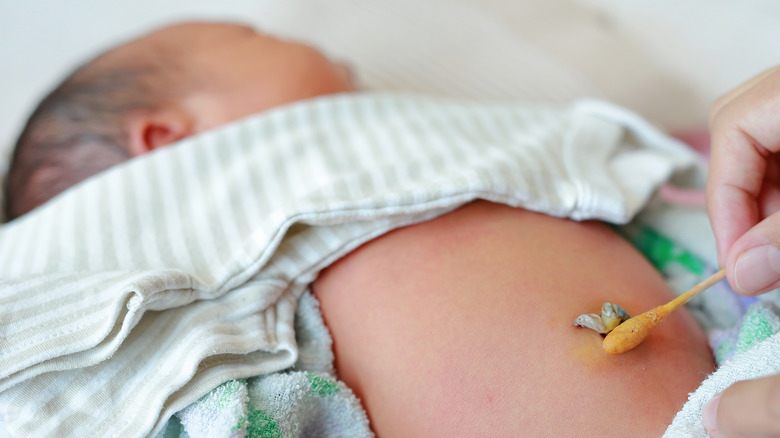High-Risk Newborns Could Benefit From Leaving The Umbilical Cord Attached Longer
When some babies are born, they don't immediately proceed to emit the typical lusty cry we all expect. According to research published by the American Heart Association in Circulation from 2010, roughly 10% of newborn infants are in need of some form of breathing assistance once they emerge from the womb. Fewer than 1% of babies require extreme resuscitative intervention. However, for those who do, the American Heart Association outlines that doctors will need to assess the infant's vital signs and initiate ventilation if necessary within one minute's time. For healthy babies, physicians often wait approximately 60 seconds before severing the umbilical cord in order to provide newborns with additional cord blood and oxygen before cutting, reports HealthDay. However this is not the protocol used for "non-vigorous" infants.
As defined by researchers from a July 2022 study published in the Journal of Perinatology, non-vigorous infants are those who display poor breathing efforts, decreased muscle tone, or a heart rate below 100 beats per minute upon their initial delivery room exam. HealthDay reports that the go-to strategy for these newborns is immediate clamping of the umbilical cord in order to begin respiratory aid. However, a new study published in the American Journal of Obstetrics & Gynecology suggests that briefly "milking" the umbilical cord before clamping could potentially lessen the severity of related respiratory or cardiovascular outcomes.
Potential health benefits of infant umbilical cord milking
The study involved more than 1,700 infants born at 35 to 42 weeks' gestation between the start of 2019 until mid 2021. The newborns in the study had been born in 10 different health facilities across Canada, Poland, and the United States, reports HealthDay. As per this particular study, non-vigorous infants were considered those with poor tone, pale in color, or those who were unable to breathe within 15 seconds following birth. Newborns were randomly assigned to one of two conditions: early cord clamping or cord milking. Those in the cord milking group underwent three rounds of gentle squeezing of 20 centimeters of umbilical cord for a period of two seconds (via HealthDay).
Findings showed that newborns in the milking group were 10% less likely to need heart and respiratory aid following birth, reports HealthDay. Additionally, low oxygen levels in the brain were observed in 3% of newborns in the early clamping group, compared to 1.5% of infants in the cord milking group. Babies who underwent cord milking were also found to have higher levels of hemoglobin and were at a lower risk for brain injury due to lack of oxygen, as per the study. However, cord milking did not appear to decrease rates of neonatal emergency care unit admissions. Although more research is needed, the study team points out that cord milking post-delivery could potentially provide benefits to infants born exhibiting respiratory issues.


